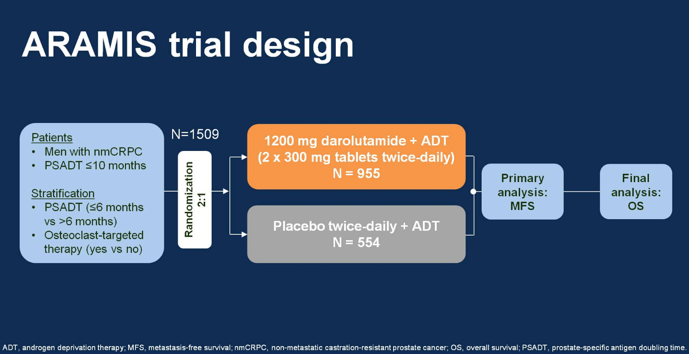ARAMIS was a double-blind, placebo-controlled phase III controlled trial in which nmCRPC patients were randomized 2:1 to receive either darolutamide 600 mg (two 300 mg tablets) twice daily or placebo while continuing androgen deprivation therapy.1 Patients were stratified by PSA doubling time (≤6 months or >6 months) and use of osteoclast-targeted therapy; key inclusion criteria were men with PSA ≥ 2 ng/mL, ECOG 0-1, and PSADT ≤ 10 months.

The primary endpoint was metastasis-free survival (MFS), with independent central review of radiographic imaging every 16 weeks; MFS was defined as distant metastases or death from any cause. Secondary endpoints include overall survival (OS), times to pain progression (assessed by Brief Pain Inventory), first cytotoxic chemotherapy and first symptomatic skeletal event, as well as safety profile. In total, 1,509 patients were randomized in the study – 955 men to darolutamide and 554 men to placebo.
Median MFS was 40.4 months with darolutamide vs. 18.4 months with placebo (HR 0.41, 95%CI 0.34–0.50), representing a 59% reduction in metastases or death among patients receiving darolutamide. OS favored darolutamide (median not reached for either arm, HR 0.71, 95%CI 0.50–0.99, 2-sided p=0.045), as did time to pain progression (HR 0.65, 95%CI 0.53–0.79; 2-sided p<0.0001), however the OS data is still immature and the final analysis will be presented in the future.
Other secondary and exploratory efficacy endpoints also favored darolutamide over placebo. PFS: 62% reduced risk of local progression, distant metastases or death (36.8 months vs. 14.8 months, HR 0.38, p < 0.0001); time to first cytotoxic chemotherapy: HR 0.43, p < 0.001; time to SSRE: HR 0.43, p = 0.011. Total Grade 3-5 AE’s was similar between the two groups: 24.7% in the darolutamide arm vs. 19.5% in the placebo arm.
This paper has subsequently been published in the New England Journal of Medicine1 and now offers men with nmCRPC three treatment options: darolutamide, enzalutamide, and apalutamide.
Presented by: Professor Teuvo Tammela, MD, PhD, the University Hospital and University of Tampere, Tampere, Finland
Written by: Zachary Klaassen, MD, MSc – Assistant Professor of Urology, Georgia Cancer Center, Augusta University - Medical College of Georgia at the 34th European Association of Urology (EAU 2019) #EAU19 conference in Barcelona, Spain, March 15-19, 2019.
References:
1. Fizazi K, Shore N, Tammela TL, et al. Darolutamide in nonmetastatic castration-resistant prostate cancer. N Engl J Med. 2019 Feb 14 [Epub ahead of print].
Further Related Content:
Read: Darolutamide Receives FDA Approval for the Treatment of Non-metastatic Castration-resistant Prostate Cancer
Read the Discussion by Dr. Peter Albers


